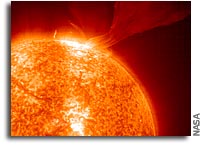Clues Found to Decades-Long Coronal Heating Mystery

Drs. Michael Hahn and Daniel Wolf Savin, research scientists at Columbia University’s Astrophysics Laboratory in New York, NY, found evidence that magnetic waves in a polar coronal hole contain enough energy to heat the corona and moreover that they also deposit most of their energy at sufficiently low heights for the heat to spread throughout the corona. The observations help to answer a 70-year-old solar physics conundrum about the unexplained extreme temperature of the Sun’s corona — known as the coronal heating problem.
Hahn and Savin analyzed data from the Extreme Ultraviolet Imaging Spectrometer onboard the Japanese satellite Hinode. They used observations of a polar coronal hole, a region of the Sun where the magnetic fields lines stretch from the solar surface far into interplanetary space. The findings were published on September 30th in the October 20th edition of The Astrophysical Journal.
To understand the coronal heating problem, imagine a flame coming out of an ice cube. A similar effect occurs on the surface of the Sun. Nuclear fusion in the center of the Sun heats the solar core to 15 million degrees. Moving away from this furnace, by the time one arrives at the surface of the Sun the gas has cooled to a relatively refreshing 6,000 degrees. But the temperature of the gas in the corona, above the solar surface, soars back up to over 1 million degrees. What causes this unexpected temperature increase has puzzled scientists since 1939.
Two dominant theories exist to explain this mystery. One attributes the heating to the loops of magnetic field which stretch across the solar surface and can snap and release energy. Another ascribes the heating to waves emanating from below the solar surface, which carry magnetic energy and deposit it in the corona. Observations show both of these processes continually occur on the Sun. But until now scientists have been unable to determine if either one of these mechanisms releases sufficient energy to heat the corona to such high temperatures.
Hahn and Savin’s recent observations show that magnetic waves are the answer. The advance opens up a realm of further questions; chief among them is what causes the waves to damp. Hahn and Savin are planning new observations to try to address this issue.
Media Contact:
Beth Kwon
Columbia University
+1 212-854-5573
beth.kwon@columbia.edu
Science Contacts:
Michael Hahn
Columbia University Astrophysics Laboratory
+1 646-708-3461
mhahn@astro.columbia.edu
Daniel Savin
Columbia University Astrophysics Laboratory
+1 646-707-4937
savin@astro.columbia.edu
Reference:
http://arxiv.org/abs/1302.5403 (preprint)
http://dx.doi.org/10.1088/0004-637X/776/2/78
This research has been supported by the National Science Foundation Division of Atmospheric and Geospace Sciences through the Solar, Heliospheric and Interplanetary Environment program.
X









